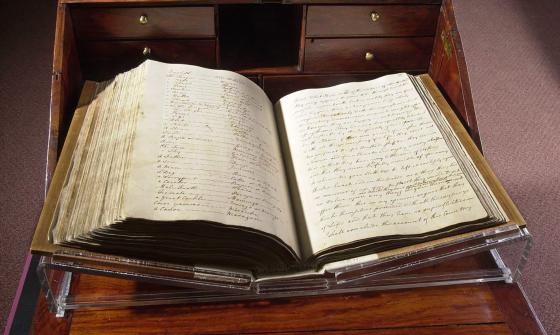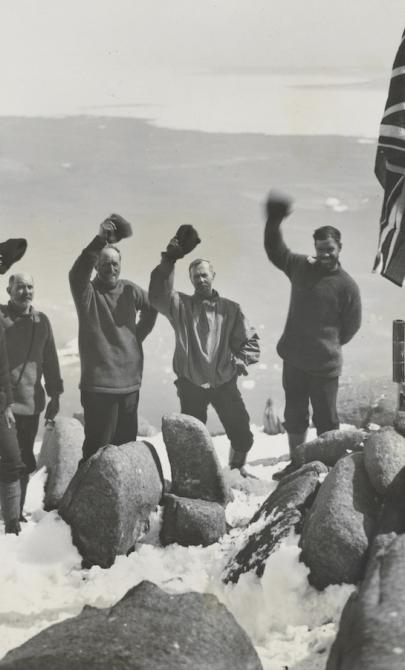First contacts
About this module
Using an inquiry-based approach, this module develops students' skills as historians through engaging historical sources. Featuring sources from the National Library's collections, the resource caters for flexible approaches to suit diverse classroom contexts and learning styles.
Copyright for teachers
You can download all collection materials in this resource for education purposes. For more information, go to copyright for teachers.
Topics in this module
This module covers 8 key topics.
Each topic includes an introduction to key concepts, links to key resources in our collection and a series of learning activities that cater for a variety of classroom contexts and learning styles.

Jacob Gerritsz Cuyp, Portrait of Abel Tasman, his wife and daughter, 1637, nla.gov.au/nla.obj-138417248

Mickey of Ulladulla, Corroboree with native animals in the distance near Ulladulla, New South Wales, approximately 1885, 1880, nla.gov.au/nla.obj-135517021

Thomas Baines, Thomas Baines with Aborigines near the mouth of the Victoria River, 1857, nla.gov.au/nla.obj-134296782

Francis Fowkes, R Cribb Neele & John Samuel, Sketch & description of the settlement at Sydney Cove Port Jackson in the County of Cumberland taken by a transported convict on the 16th of April, 1788, which was not quite 3 months after Commodore Phillips's landing there, 1789, nla.gov.au/nla.obj-230578175

James Cook, John Hutchinson, Samuel Wallis and Henry William Ferdinand Bolckow, Journal of H.M.S. Endeavour, 1768-1771 [manuscript], 1768, nla.gov.au/nla.obj-228958440

Arthur Bowes Smyth, Journal of Arthur Bowes Smyth, 1787, nla.gov.au/nla.obj-233364776

Joseph Lycett, Family of Aborigines taking shelter during a storm, 1817, nla.gov.au/nla.obj-138500126

Peter Mazell, James Cook & John Webber, An opossum of Van Diemen's Land, 1784, nla.gov.au/nla.obj-136182204
Introductory activities
These activities aim to facilitate a shared understanding of the themes and concepts relevant to Year 4 History. They provide a context for students before they explore related sources from the Treasures Gallery.
The first two activities introduce students to the ideas of exploring the unknown and interactions between people from different cultures. The third activity empowers students to shape their own learning about the settlement of Australia by Europeans
Activity 1: Facing the unknown
Tell your students they are about to embark on an expedition to Mars. Work with them to imagine this scenario. The expedition will last for more than a year, including several months of travel, and they will need to make observations about the planet when they arrive. Encourage your students to respond to the following questions in a class discussion:
- What are your hopes?
- What are your fears?
- How do you feel about making this expedition?
Now ask students to imagine the experience of world explorers who set sail for unknown lands hundreds of years ago.
Activity 2: First contact
First contact between groups with different perspectives, understandings and cultures is always a challenge. Use this activity to help your students explore what might have occurred during first contact between different cultural groups in Australia. (The game is adapted from the Tribal Game activity in the resource Difference Differently.)
Print and cut out multiple copies of the game cards. Randomly assign a card to every student in the class. These cards explain the name and behaviours of five distinct cultural groups.
Give students time to read their cards and tell them they must take on the behaviours of their group.
Ask students to move around the classroom and, without speaking, greet other players. Conclude the game after 3─5 minutes; the classroom will probably be quite chaotic by this time.
The real power of this activity lies in the debriefing phase. Conduct a debriefing session with your students using the following questions:
- What happened during the game?
- How did you feel when someone had a behaviour that was different from your own?
- How did you feel when you met someone from your own group?
- Do you ever have similar feelings in your everyday life? When?
As a class, discuss this activity in the context of the European settlement of Australia.
Activity 3: European settlement of Australia
In this activity, students work together to share their current understandings of, and shape an inquiry into, the European settlement of Australia. Ask students to respond to the following questions:
- What do you know about the settlement of Australia by Europeans?
- What do you want to know about the settlement of Australia by Europeans?
- What resources could you use to discover more about the settlement of Australia by Europeans?
Concluding activities
These activities encourage students to apply the concepts relating to first contacts to their experiences as Australians today. As part of this process you may also like to revisit the questions students developed in the introductory activity about European settlement of Australia.
Activity 4: The story behind names
Ask students to research evidence of Australia’s past in the names of:
- states (for example, New South Wales)
- rivers (for example, Yarra)
- landmarks (for example, Uluru)
- towns (for example, Wagga Wagga)
- suburbs (for example, Forrest)
- roads (for example, Oxley Highway)
- streets (for example, Wentworth St).
Your students may like to create labels to record their evidence and then attach each label to the appropriate location on a map of Australia.
Activity 5: History on our flag
Ask your students to complete a PMI (Plus, Minus, Interesting) activity in response to the statement: The Australian flag should be changed. Then invite them to design a flag they think reflects Australia’s history.
Activity 6: Reconciliation
The Treasures sources in this resource have explored first contacts, particularly in relation to European settlers and Aboriginal and Torres Strait Islander peoples. Millions of immigrants have come to Australia since the arrival of the first European settlers and reconciling cultural differences has been an ongoing process. Ask your students to explore any links between Australia’s history and the process of reconciliation in the Australian community today. They can do this by writing an acrostic poem on the theme of R.E.C.O.N.C.I.L.I.A.T.I.O.N.
Curriculum links
This resource aligns with the Australian Curriculum: History for Year 4 students in Humanities and Social Sciences.
The resource meets cross-curriculum priorities and promotes the use of historical skills such as analysis and use of sources, perspective and interpretations, and explanation and communication. The resource also has relevance to the Geography, and Civics and Citizenship strands, the English learning area and to the General Capabilities of Literacy, Critical and Creative Thinking, Intercultural Understanding, and Personal and Social Capability.
- The diversity of First Nations Australians, their social organisation and their continuous connection to Country/Place (AC9HS4K01)
- The causes of the establishment of the first British colony in Australia in 1788 (AC9HS4K02)
- The experiences of individuals and groups, including military and civilian officials, and convicts involved in the establishment of the first British colony (AC9HS4K03)
- The effects of contact with other people on First Nations Australians and their Countries/Places following the arrival of the First Fleet and how this was viewed by First Nations Australians as an invasion (AC9HS4K04)



